If you have been living under a rock in the last year or so, then you might have missed the news about the most popular tech trend that’s shaking the world. I am, of course, talking about drones which are becoming huge parts of our everyday lives. When they first appeared on the market they had expensive price tags on them and to be honest, they were primarily designed for experienced pilots.
Table of contents :
– Beginner drones under $100
– Beginner drones from $100 to $300
– Beginner drones from $300 to $600
– Beginner drones above $600
There were only a few drones for beginners back in that time. Back then, they weren’t equipped with technologies such as stability systems, GPS for drones and autonomous flights, all of which greatly help beginner pilots.
With this being said, if you have just started doing your research on modern day drones and would really like to buy one, but you ended up with a huge surplus of information and you’re no way near the end result… Don’t worry, this list has got you covered. You’ll soon find out what are the best drones for beginners. It features some of the best drones that are suitable for beginners in all aspects. Most of the drones on this list do have a camera, so we won’t create a separate section featuring the best beginner drone with camera. So, without further adue, let us start with the list!
Drones for Beginners FAQ :
In terms of cost, I would be lying if I told you that you have to spend a lot of money on a good beginner’s drone. In fact, the story goes pretty much the exact opposite of the above-stated claim. Beginner friendly drones are usually those which just have easy controls and can take quite a beating. When it comes to their pricing, you probably won’t need to spend more than $200 on your best beginner drone 2017.
After you have gotten accustomed to the controls and you wish to step up your drone game, then (and only then) I would recommend going up a notch and aiming for a mid to high-end drone. So the conclusion is, the best starter drone doesn’t have to be expensive. Sure, you can go ahead and dash out close to $1000 but I wouldn’t recommend it if you’re a first-time flyer!
So, you have never operated a drone before and you are finally ready to make your dream come true. But, as soon as you started your “shopping” routine, you stumbled upon more than a few issues. The main one is certainly the type of drone you should look for.
It’s safe to say that modern day drones possess a plethora of unique characteristics. If you are a beginner (and I suppose you are since you are reading this article), or you’re buying a drone for your kid, the most important one you should look for in your first drone is ease of use. Drones (especially higher end models) can be tricky to operate properly and require a lot of training before jumping into the action. That’s why you need to make sure your best beginner drone 2017 incorporates intuitive controls without needlessly large operating manuals and all that other complicated stuff.
In addition to that, you should also make sure your first drone is not made out of cheap plastic materials. Since you’re a beginner, you will most likely end up crashing it a couple of times before you get the controlling scheme correct. In order to minimize the chances of breaking your drone during the very first crash, make sure it has prop guards and solid build quality to start with.
So, to summarize – there are just 2 main aspects that you should consider when purchasing your first drone: ease of use and build quality. Start off with those 2 and build your way up to more precise characteristics that are subjective to your needs…
- CCD sensor
Stands for Charged Coupling Devices. This type of camera sensor turns images from analog signals of light into digital pixels you see on your displays. They allow smooth images and capture great amounts of light making them extremely viable for professional FPV racing. But, all that comes at a price – the process of manufacturing CCD cameras is more expensive than CMOS. - CMOS sensor
Cameras running CMOS sensors have established themselves as the standard and are being used in virtually all camera-equipped gadgets. CMOS stands for Complimentary Metal Oxide Semiconductor and these chips use transistors with each pixel for moving the charge. This leads to every pixel being treated individually allowing for much better power consumption. - Resolutions
When it comes to the resolutions the good old rule “the more, the better” works like a charm. With that in mind, here’s the list of all resolutions you can expect to see from drones costing mere $50 all the way to $1000:
- 640×480 – VGA
- 1280×720 – HD
- 192×1080 – Full HD
- 3840×2160 – 4K
- The bigger your drone’s camera resolution is, the better (generally speaking) your aerial photos and videos will be. However, there are also other factors that come into play such as the sensor type, size, lens, aperture and more.
- FPV
Stands for First Person View and basically refers to a drone’s ability to provide its users with a live feed straight from the mounted camera. A lot of drones these days come with this option and people get generally confused when they see that there are 2 main types available. The first type is WiFi FPV - Gimbals
With high-end drones, you will often hear the term gimbal. Most frequently, the term will be related to a 3-axis gimbal which holds the camera in place. These gimbals are basically sophisticated stabilization mechanisms which ensure the optimal stability of your aerial shots thanks to comprehensive hardware found inside. In most cases, they are powered by brushless motors (more on that below) and tend to cost a big portion of the drone’s price. - Mounts
In contrast to gimbals, mounts provide the most basic method of attaching video cameras to drones. As their name implies, mounts serve as a mounting platform for cameras and don’t provide any electric parts for image stabilization. In best cases, they come with some sort of anti-vibration mechanisms (such as dampening balls) which slightly improve the overall image stability.
- Brushless motors
Brushless DC motors are present in virtually all higher tier drone models. They offer superior power/weight ration and are generally considered as better options than brushed ones. That’s mostly because of their durability which is not even comparable to their brushed counterparts which have roughly 4-5 hours of working lifespan. - Brushed motors
Brushed DC motors have one big thing that works heavily in their favor – price. They are extremely cheap to manufacture but rely on miniature brushes which keep the spinning on. They wear out with time so, looking at the long scheme of things, brushed motors offer worse value for money when compared to their brushless counterparts. - LOS
Stands for Line of Sight and is usually mentioned in the context of FAA (and other government bodies) regulations. For example, in the USA drone operators are required (by law) to fly LOS-only. - BVLOS
Stands for Beyond Visible Line of Sight. This term is usually referred to in the context of FAA regulations which forbid all drone operators from BVLOS flying. - No-fly zones
If you are living in the USA, you might hear the term no-fly zones related to UAV flights. These zones are closely related to public places of interest, government buildings, stadiums, airport and other similar infrastructures above which flying drones could pose a threat. - Headless mode
If your drone has headless mode, it means that you can control it in a completely different way. You see, with standard controls, the orientation of your drone plays the key role. However, when you turn on headless mode, the orientation is taken out of the equation and the controls are relative only to the movements you make on your controller. - Payload
As far as the payload is concerned, it basically represents the amount of weight the drone can carry in addition to its own body and hardware inside. First things first, drones under $500 are usually not able to carry a lot. Perhaps a small action camera and that’s about it. If you are looking for high-payload drones then I’m afraid you will have to look into the above $1000 section of drones market. - GPS features
If your drone has GPS, chances are high it will also have some (if not all) of the following features: waypoints, follow me, altitude hold, orbit, cable cam etc. These supporting features are sometimes referred to as GPS features since they all require the GPS model in order to work as planned. - Waypoints
Waypoints mode falls in the category of GPS features. As its name implies, this feature allows you to draw a path with several waypoints which your drone will follow. Depending on the drone you have, there will be lots of settings you can change to get the Waypoints mode to suit your exact needs. - Follow Me
Follow Me mode takes advantage of the drone’s GPS module and allows it to follow you (or virtually any other object or person) everywhere you go. There are also several variants or subtypes of this feature. They include Dynamic Follow, Static Follow, ActiveTrack, Orbit, Panoramic Follow and plenty more… of course, depending on the model you have/will buy. - Dronie
Dronie is a relatively new term that got around with popularity growth of selfie drones. But what does it mean? Well, a dronie is basically a selfie taken with a drone. Nothing more, nothing less… - RTF
Stands for Ready To Fly. RTF drones come with everything needed to get them up and running. They include batteries, transmitter, receiver and basically everything else needed to fly the drone straight out of the box. - ARF
Stands for Almost Ready to Fly. ARF drone packages do not contain transmitters or receivers. In some cases, even the batteries have to be purchased separately. They are meant for more advanced users who know their way around drone parts. - BNF
Stands for Bind and Fly. These drones come with receivers and batteries (and everything else) but lack transmitters. BNF models are the majority in high-end FPV racing drone market where users already have top tier transmitters and only need the actual drones.
However, if you already have some experience with flying drones (at least 1 or 2 flights) and you already know the basics of flying without crashing into nearby objects, then a camera might be a good addition. With it, you will be able to learn more advanced flight paths such as manually following objects in your camera’s focus on perhaps keeping a steady orbiting pattern around a certain object by paying attention to the FPV view.
Long story short – cameras are not an outright necessity for first-time flyers, but they can prove to be valuable in the long run, especially for people who would like to dedicate a lot of future time on getting good at aerial photography.
However, we can divide modern day drones into 2 sections as far as the good old “what will happen when my drone goes out of range” question is concerned:
GPS Drones
Short story – Drones equipped with a GPS module will return back to their starting location if they happen to go out of range. Keep in mind that this is not present with all drones. Plus, on some of them, you will have to manually set this feature up if you want it to work.
Long story – To keep your drones from going away on their own after losing signal, GPS drones have specialized FailSafe options which ensure the drone’s safety. They are commonly referred to as return-home and land failsafe
Non-GPS Drones
Unfortunately, cheap drones that are not equipped with GPS usually end up just like mine did. It flew away into the distance and I haven’t had much luck finding it. And I’ve looked everywhere. That’s probably because the drone remembered my last command input (which was full throttle and pitch forward) and flew further away for God knows how long.
That’s the usual thing that happens when a non-GPS drone goes out of range. Some drones remember the last input until they crash while some remember the last input just a few seconds after losing the signal. Either way, you’re up for a solid dose of searching afterward.
Starting off with cheap (toy-grade) drones, when they completely run out of battery, they will, unfortunately, drop down from the sky. However, every drone has a low-battery alarm system in place. These are quite different but generally what you’ll be looking at is flashing LEDs on the drone, buzzing sound on your controller or some sort of a visual warning message on your smartphone’s app. Either way, you will be promptly notified.
On the other hand, expensive drones usually have low battery voltage failsafe feature which allows them to safely land when their battery is near gone. This doesn’t mean you should stop paying attention to your battery levels since your drone might land somewhere too far from you and you won’t be able to locate it. Luckily, expensive best beginner drones 2017 also feature alarms which will notify you if your battery is on critical levels.
1. Stay calm and enable headless mode on your drone. Once you are in this mode, simply rotate the pitch/roll stick to yourself and hopefully you will see your drone slowly return to your location.
2. If you own a GPS drone, returning your drone after losing orientation is even easier. Simply enable the Return to Home feature on your smartphone/controller and that’s pretty much it. Keep in mind though – some models require you to manually set up your drone’s home location.
best starter drone under $100
Table : Best drones for beginners under $100
| Image | Name | Battery | Range | Price |
|---|---|---|---|---|
| 5. Holy Stone F181 | 9min | 100m | See price now | |
| 4. UDI U818A HD+ | 9min | 100m | See price now | |
| 3. Blade Nano | 7min | 20m | See price now | |
| 2. Hubsan H107D | 7min | 50m | See price now | |
| 1. Syma X5C | 7min | 70m | See price now |
5. Holy Stone F181

Features
The F181 is an outstanding drone with a bunch of handy features such as headless mode, one key return, altitude hold and even one key 360 flips. Keep in mind though, one key return and altitude hold aren’t GPS-powered so don’t expect them to be as precise as those. Even despite that, I’m sure many will agree this is one of the best starter drones out there!
Performance
As you will have the chance to see down below, Holy Stone F181 has a lot more features than the X5C by Syma, but to its defense, the F181 is more than double its price. In addition to all of these features, this little fella is equipped with an HD camera as well. It doesn’t have any form of stabilization which is not surprising at all… It is not the best beginner drone with camera, but it can still take solid shots and the occasional video. To top it all off, you will be happy to find out that HOly Stone F181 is able to fly for up to 9 minutes and can reach up to 100 meters.
4. UDI U818A HD Plus – Good starter drone

Specifications
But not only is it popular, it looks cool as well. With 1 pair of black and 1 pair of white blades surrounded by built-in prop guards, this drone has quite a sexy look to it. Still, when it comes to flight range it is only capable of going up to 100 meters. Luckily, its flight duration improves its image – you can get around 9 minutes on a full charge. Get an extra battery and you’ll have close to 20 minutes of flight time (with 1 pit stop, needless to say) which is kind of crazy for such a cheap drone.
Final thoughts on this one
All things considered, UDI 818A Plus is a solid contender for the best value for money in “under $100” price range. Keep in mind that it’s a drone specially designed for beginners and will most likely disappoint more experienced pilots. Despite that, it’s still definitely worth trying out!
3. Blade Nano RTF

Beginner-friendly racing drone
Yes! Blade Nano is an excellent choice for beginners, even more so for beginners with FPV racing tendencies. This birdie is a fully stabilized model that can easily be equipped with a lightweight FPV camera. Something like the popular Eachine TX01 should do the trick for you. It’s a micro all in one FPV system (camera, vtx, and antenna) that will do you a world of good with these lightweight brushed models. Try it out and you’ll realize what I’m talking about. By equipping those tiny cameras (and combining them with a solid VR goggles) you will get to enjoy thrilling FPV experience that is bound to teach you the basics of flying.
Specifications
In terms of numbers, Blade Nano QX has half of the story right on spot. We are talking about flight time which goes up to 7 minutes thanks to the 1S 150mAh 25C LiPo battery. It provides quite the punch too, meaning it’s definitely worth stocking up. However, the range with this RTF package isn’t the greatest. It only goes up to 15-20 meters which is way too low for today’s standards. However, there is a BNF version too which can be connected to DX5E transmitter which boosts the range by A LOT!
2. Hubsan H107D
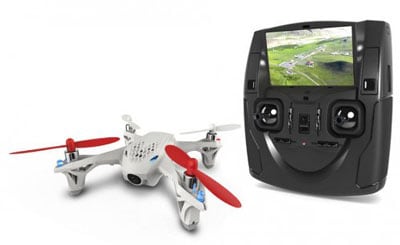
Performance
As far as the performance is concerned, Hubsan H107D is quite a little champ. As I’ve already stated above, this tiny little birdie runs on brushed motors and sports a sturdy frame which is crash resistant. It’s not crashproof so don’t go slamming it into walls or anything like that. In terms of numbers, Hubsan H107D can fly around for roughly 7 minutes and reach as far as 50 meters away from its controller. However, it is barely seeable at this range and without the FPV system turned on, I doubt you will be able to properly test it out.
Camera
Yes, this little birdie comes with an FPV system straight out of the box. It is not a high-quality one, just a 480p camera that. Luckily though, it works via the 5.8GHz connection which is, as you probably all know, far superior to WiFi.
1. Syma X5C – best starter drone ?

Camera
Like I already said above, Syma X5C is a easy to fly drone that perfectly fits your needs if you’re a first-time flyer. Not only is it made out of decent quality plastic (can’t expect premium build quality for this price) but it also sports a pretty decent 2.0MP camera (If the camera is an important factor to you, check out our list of best camera drones) that can provide you with decent quality images… as long as you don’t expect any masterpieces.
Features and specifications
It has a 6-axis gyro stabilization system for optimal stability along with one button 3D flips. Other than that, it is also important to add that you can fly it around for about 7 minutes and it can reach about 70 meters away from its transmitter. All things considered, we are talking about a dirt-cheap drone that serves great as flying practice for new pilots. Buy it, test it out and see for yourself.
$100 to $300
Table : Best drones for beginners from $100 to $300
| Image | Name | Battery | Range | Price |
|---|---|---|---|---|
| 5. MJX Bugs 3 | 15min | 300m | See price now | |
| 4. Altair AA108 | 10min | 100m | See price now | |
| 3. Hubsan H501S | 20min | 300m | See price now | |
| 2. MJX Bugs 2W | 18min | 500m | See price now | |
| 1. Upair One | 18min | 800m | See price now |
5. MJX Bugs 3
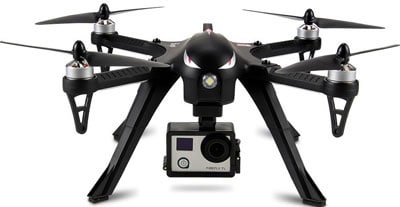
How does it perform?
This entry level drone comes without a dedicated (or built-in) camera but makes up for it with a great support for a wide variety of action ones to suit your cravings for aerial photography. In terms of specifications, MJX Bugs 3 is more than good beginner drone, especially considering its low price. It runs on a 1800mAh LiPo battery that can hold it up in the air for about 15 minutes.
You will also have roughly 300 meters of flying range which should be enough for all your casual or aerial photography needs. When it comes to ease of use, it’s safe to say that there aren’t many better models than this one. Its controller is highly intuitive and responsive, allowing even the first-time pilots to have fun with it.
Summary
So, long story short – if you are a beginner but you still want a great drone that can do a lot (in terms of features) and still remain intuitive and easy to use, then MJX Bugs 3 is a great choice! With a fine array of supported action camera models and great flight stability, I am positive that there are not many better drones in this price range… only 4 of them to be more precise!
4. Altair AA108 – easiest drone to fly ?

Specifications
Starting off with the hardware, inside of Altair AA108 you will find a 1S LiPo battery, a basic 6-axis gyro stabilized FC and 4 brushed motors. This battery is capable of keeping it up in the air for approximately 10 minutes which is not half bad considering the price this beauty goes for. Furthermore, the motors are actually pretty damn powerful and (considering the lightweight design of this birdie) are able to provide good thrust/weight ratio. However, Altair AA108 is not a racing drone so don’t expect neck-breaking speeds. Operating range is solid too, going up to around 100 meters in a clear, unobstructed area.
Camera
Probably the best thing about Altair AA108 is its brilliant miniature camera that can record in HD. We are talking about a wide angle sensor here (120-degrees FOV) which is perfect for taking shots and videos from high altitudes. Of course, it has no stabilization (hardware or software) so you will experience a bit of jello effect every now and then.
Features
The first thing I’d like to say about the features of this little birdie is the FPV. Even though it works over WiFi, it does an amazing job of providing new users to real-time FPV immersion. It is accompanied by non-GPS based features such as altitude hold and flight route options (among others) and they work surprisingly well considering this is not a smart drone. So, with everything that we had the chance to see from Altair AA108, I’m sure it’s safe to say that it’s one of the best beginner drone 2017.
3. Hubsan H501S
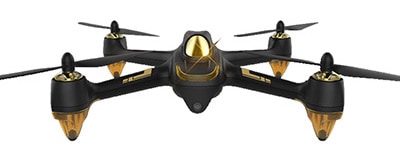
Camera and FPV system
Hubsan H501S comes packed with an FHD camera capable of shooting outstanding aerial footage. If that’s not your thing, then perhaps you’ll be satisfied with a 4.3-inch LCD screen for FPV monitoring that’s built into the controller. The controlling works with 2.4Ghz connection while FPV uses a much more reliable (and stronger) 5.8Ghz.
Features and specifications
Moving forward, features include GPS, auto return to home, altitude hold, headless mode and best of all – follow me feature. In terms of specifications, the situation is solid nonetheless. Flight time is roughly 20 minutes and the range goes up to 300 meters without any issues. Do you think this is the best beginner drone with camera?
Well, considering everything it has going in its favor, I suppose Hubsan H501S is among the best ones… at least in this price range. It offers great value for money and as such it surely deserves your attention.
2. MJX Bugs 2W

Performance
If you are worried that this easy to fly drone doesn’t perform as well as its predecessor due to a small decrease in size, I’m happy to tell you that you are terribly wrong. You see, MJX Bugs 2W has more range and airtime than MJX Bugs 3… and packs all that into a smaller package. It’s a win-win situation like no other! If we are to be more precise with our numbers here, MJX Bugs 2W can hold on in the air for up to 18 minutes. If you plan on recording and going full speed all the time, then the airtime will be slightly lowered to roughly 15 minutes. Moreover, the range has received a slight boost as well, with roughly of 500 meters at your disposal.
Camera and features
Starting off with the camera, MJX Bugs 2W sports an FHD sensor that pointed a bit downwards which indicates this is a drone meant for beginner aerial photographers. In this price range, MJX Bugs 2W is the best beginner drone with camera. Features-wise, similarly to its predecessor, Bugs 2W keeps the GPS, altitude hold and one key return to home features and further improves the show with WiFi FPV which works anywhere from 300 to 500 meters. All things considered, if you are planning on pursuing a career as an aerial photogrpher, then MJX Bugs 2W is the perfect choice for you ! It’s a probably the easiest drone to fly in this category.
1. Upair One
If you’re an Apple fan, you will really like this drone. The build quality (and design) is nothing short of spectacular. It sports a minimalistic, clean white finish and awfully resembles DJI Phantom series. The controller breathes the exact same qualities as well – with its huge 7 inch LED display for FPV monitoring it will surely stand out from the crowd. What else stands out? Let’s take a closer look and see!
Great camera
Upair One is equipped with an outstanding 2.7K camera that can, in combination with its stability systems, capture great aerial footage time in and time out. You can upgrade your purchase for roughly $50 and opt for a 4K camera package if you’re into aerial photography. This is my favourite beginner drone with camera. Upair one also has a smart battery which lasts up to 18 minutes on a single charge which is a great trait nonetheless.
Features aren’t half bad either
When it comes to its features, it has a dedicated GPS system, one key return function, auto return, failsafe return and much more. Specifications-wise, this little guy works via 5.8 GHz frequency which enables it to fly up to 800 meters away from its transmitter without ever loosing connection. But still, keep in mind that if you have FPV turned on, you probably won’t make it further than 500 meters. Undoubtedly, that’s a great distance nonetheless, especially considering you get a crisp clear image on a 7 inch LED display. With all of the above in mind, there is no doubt that Upair One is a must-have if you are thinking of making drones your main hobby.
$300 to $600
| Image | Name | Battery | Range | Price |
|---|---|---|---|---|
| 5. 3DR Solo | 20min | 800m | See price now | |
| 4. Traxxas Aton Plus | 15min | 300m | See price now | |
| 3. Hubsan H109S | 30min | 1000m | See price now | |
| 2. DJI Spark | 15min | 2000m | See price now | |
| 1.Bebop 2 Adventurer | 25min | 2000m | See price now |
5. 3DR Solo
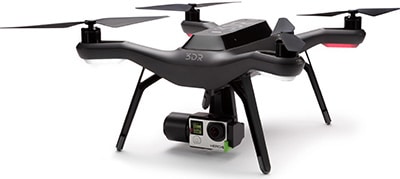
Features are a strong point
The price is significantly higher than the standalone drone, but the gimbal itself is amazing and will serve as a great aerial photo platform, especially if you have a top-quality action camera. For those of you who don’t know what a gimbal is, please refer to the FAQ section above. Furthermore, features aren’t to be taken for granted either. 3DR Solo is a true smart drone in every sense of that word and doesn’t just possess GPS but Follow Me, Waypoints and plenty other features that ensure its competitiveness on the market.
Great build quality
Other than that, it is important to add that this drone simply breathes quality. It’s made out of sturdy and durable lightweight material and possesses a bunch of handy features such as orbit mode, follow me, cable cam and even a dedicated selfie mode.
When it comes to its specifications, the 3DR is nothing short of brilliant. With more than 800 meters of clean, lag-free experience and around 20 minutes of flight duration, you can’t expect to find anything even remotely close to this for just $330.
4. Traxxas Aton Plus
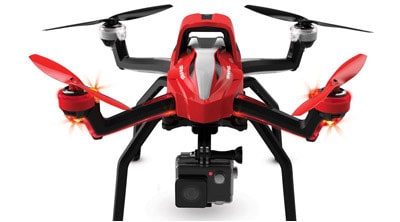
This is a speedy little devil
Besides that, it is important to add that Aton is an extremely speedy drone, clocking in at around 80 kilometers per hour (50mph) in its sports mode. But if you switch from sports to film mode, the drone’s speed will be lower but its stability, control accuracy and smoothness will all greatly increase, giving you a sensational flying experience.
Features
With dual mode GPS system, return to home, bright LED lights, 2 flight modes and air brakes, it’s needless to say that we are talking about a very high-profile drone.
To top it all off, its range is maxed out at around 300 meters even with FPV on (yes, it supports great FPV experience if you pair it with a decent action camera), but at that distance, I doubt you’ll be able to see it quite clearly.
3. Hubsan H109S

With features such as GPS system, headless mode, altitude hold, auto return, follow me, and even an Android-powered controller, there is no doubt that this drone has all it takes for you to start off your drone piloting career.
A full HD camera that is able to shoot great aerial footage carries the photography flag, mounted on a motorized gimbal for extra stabilization. It is pretty clear that this drone doesn’t joke around when it comes to aerial photography, that’s for sure!
Specifications aren’t to be taken for granted either
But wait, it gets better! When it comes to its specifications, things are starting to look outright unearthly. For just $400 you will get a drone that can fly for almost half an hour on a single charge. Combine that with its flight range of around 1 kilometer and you’ll realize why this drone is ranking so good on the market.
All things considered, for this relatively modest price, it’s obvious that Hubsan H109S X4 Pro is a great option. Unfortunately, it is not that popular as other similarly priced drones. The word underrated would be a good term to start off with, but I’m sure its luck will change as soon as the word of its awesomeness spreads…
2. DJI Spark

Camera
Stepping away from its size, DJI Spark incorporates a miniature FHD camera with a 2-axis stabilizer for improved smoothness of your aerial shots. Don’t let the 2-axis term fool you, Spark’s camera offers more than awesome image quality that even fully fledged (read bigger) drones wouldn’t be shy of.
Specs
In terms of specifications, it was too much to ask for them to be anything close to the Mavic Pro. Of course, at this price range, such a thought would be nonsense. Still, the Spark is paring pretty well against similarly priced competitors.
Roughly 2 kilometers of range (when you’re operating via its dedicated controller) and 15 minutes of flight time are more than a pleasant combination. You’re getting plenty of time for selfies and aerial shots and decent range for exploring that weird noise down the street at 4 AM… Do you agree this is one of the best starter drones?
1. Parrot Bebop 2 Adventurer

Packaging
Parrot Bebop 2 Adventurer, as its name implies, puts the focus on adventures. That’s why, in addition to the drone itself, this packaging includes the Skycontroller 2, Cockpitglasses and even a specialized backpack to make Parrot Bebop 2 even more travel-friendly. The backpack was specially designed with adventurers in mind and is able to fit not only the drone but all of its accessories as well.
Camera
Stepping away from the packaging, let’s talk a bit about the camera in question. As some of you already know, Parrot Bebop 2 sports a full HD camera with EIS (electronic image stabilization). Obviously, it is capable of recording breathtaking aerial videos. Combine this camera with Parrot’s FPV goggles (or Cockpitglasses, if you please) and you will get an immersive experience. If you want to take things one step further, you can also use Bebop 2’s smart flight features and make the drone follow you… or even set up a custom flight route and concentrate solely on getting the perfect shot.
Performance
Lastly, performance. Don’t worry, things won’t turn from awesome to meh here. As a matter of fact, they’re continuing in the same fashion with around 20 to 25 minutes of flight time and up to 2 kilometers of operating range thanks to the provided Skycontroller 2. If you want more flight duration from your Bebop 2, you can always buy an extra battery and carry it along with you on your adventures. Parrot Bebop 2 Adventurer makes it a lot easier, don’t you agree?
over $600 easy to fly drones
| Image | Name | Battery | Range | Price |
|---|---|---|---|---|
| 5. Yuneec Q500 | 25min | 1000m | See price now | |
| 4. Autel X-Star Premium | 25min | 2000m | See price now | |
| 3. DJI Phantom 4 Pro | 27min | 7000m | See price now | |
| 2. GoPro Karma | 20min | 2000m | See price now | |
| 1. DJI Mavic Pro | 27min | 7000m | See price now |
5. Yuneec Q500
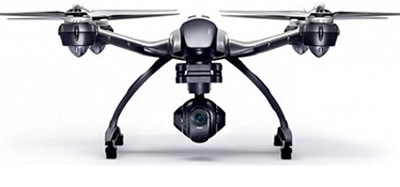
Yuneec means business
You might ask yourself – but why should I buy an $800 drone as my first one? Well, despite its awfully high price, you will get a top-quality tech gadget that is actually ridiculously easy to control. Why is that so? Well, when compared to some of the cheaper drones (some of which have been actually featured in this list), the Q500 showed off incredible responsiveness and superior flying assistance, making it by far the most beginner-friendly drone on the market.
In addition to all of this, the Q500 comes with an excellent ST10+ controller which is able to effectively control it up to 1000 meters. It seems crazy, huh? Don’t worry, you’ll be able to use roughly half of that range with proper immersion thanks to Q500’s FPV feature.
The numbers are looking good…
To be more precise, with the FPV turned on you will be getting somewhere around the 500-meter mark, and we can all agree that’s an excellent number in its own right. As far as the flight duration is concerned, despite Yuneec claiming it can reach 30 minutes, in real-life scenarios you’ll be more than happy with 22-25 minutes; still pretty awesome and among the best specs in this price range.
4. Autel Robotics X-Star Premium

Design and build quality
The first thing you will notice about this drone is its bright orange body that gathers all looks from nearby people. It is almost on the point of being fluorescent… so talk about color brightness. But it’s nice, I personally love it as it makes X-Star Premium stand out from all other drones out there. The build quality makes it stand out even further with industrial grade materials that are bound to keep it in one piece even if you manage to crash it.
Specifications
When it comes to the specifications, there is no doubt that Autel Robotics X-Star Premium will amaze you with what it has to offer. Take the range as the perfect example – this birdie can reach 2 kilometers and is able to do so with full FPV coverage thanks to a powerful VTX system. Furthermore, X-Star Premium sports a 14.8V 4900mAh LiPo battery. Yup, that’s a 4S battery right there, and it can hold it up in the air for up to 25 minutes. Realistically you’re looking at slightly above 20 if you plan on recording with the provided camera.
Camera
Yes, Autel Robotics X-Star Premium comes with a camera too. As a matter of fact, it comes with a brilliant camera mounted on a 3-axis gimbal for the ultimate aerial photography experience. It is capable of recording in 4K at 30 frames per second and does so in a smooth, vibration-free manner. Combine that with GPS/GLONASS modules, plenty of smart features to choose from and a professional transmitter and you will realize just how good this beast is! In the end, it seems as though Autel Robotics X-Star Premium is a drone with no flaws… and it might just be true, I tell ya!
3. DJI Phantom 4 Pro
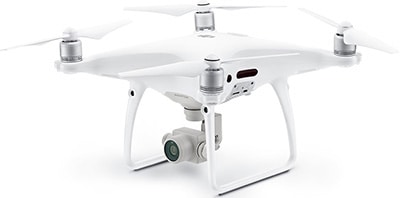
First off, as is the case with most GPS powered drones, the Phantom 4 is able to fully assist you while flying so you can concentrate more on taking the perfect shot or finding the perfect angle for your aerial video. So, it’s quite clear that the beginner-friendly aspect is present.
P4 Pro is an unparalleled aerial photography platform!
Additionally, with its 4K Ultra HD camera sporting a 1-inch sensor, professional grade photos/videos should not be an issue, especially considering the fact it can shoot slow-motion footage in glorious 4K resolution if you need to capture some dramatic shots. Combine all of that with incredible gyro stabilization accompanied by a motorized gimbal, and you got yourself a great drone. DJI Phantom 4 Pro is one of drones compatible with FPV Goggles.
Specifications
To top it all off, this little fella can fly up to 7 kilometers (yes, you read that right) and its respective flight duration varies from 25 – 27 minutes, even with the camera turned on. These numbers are truly amazing, but people tend to expect amazing things from a drone that costs more than a small fortune.
Summary
All things considered, there is no doubt that all drone pilots, no matter whether they are experienced or first-time flyers, will really enjoy piloting this beast. With a huge price tag comes great performance, and that is exactly what can be said about DJI’s newest professional aerial platform called Phantom 4 Pro.
2. GoPro Karma

Breaking the boundaries between aerial and handheld photography
That special accessory I announced above is called Karma Grip. It effectively breaks the boundaries between aerial and handheld photography by providing its users with a versatile imaging stabilization. Karma Grip is basically a handheld/body-mounted stabilizer which transforms your aerial platform package into a handheld one. It’s as simple as detaching the camera (GoPro Hero 5 or GoPro Hero 6) and attaching it to the Karma Grip.
General Performance
Even though DJI Mavic Pro has superior numbers as far as the specifications are concerned, GoPro Karma doesn’t fail to deliver either. With approximately 20 minutes of flight time and cca 2 kilometers of operating range, Karma stands tall and looks to be set on making a proper name for itself. Smart flight features are here as well, supported by GPS – they’re bound to make your aerial recording tasks a lot easier.
Build Quality
Knowing GoPro’s reputation, it is not surprising at all to see their Karma drone built with high-quality materials. The design is elegant and simply breathes quality which is always a good sign. However, the price suggests that too – you will have to pay a lot more than for the Mavic Pro if you want this little fella…
1. DJI Mavic Pro

But, for those of you who have, here’s the deal: Mavic Pro is DJI’s smallest (or, I should probably say was DJI’s smallest before the Spark) drone that can nicely fold up and fit in a laptop backpack, and can still boast with excellent hardware. It’s true – this tiny easy to fly drone is a proper beast and well capable of delivering across all departments. Crazy, huh?
This thing can perform!
DJI Mavic Pro brings no compromises to the table with amazing 7 kilometers of range and 27 minutes of flight time, miles (and minutes) more than any other miniature drone on the market. With such a significant boost to the hardware part, DJI ensured their Mavic Pro will be a hot topic for months to come. The customers are loving it and it’s slowly but surely becoming a standard in foldable drones portion of the market.
DJI GO App better than ever!
Features aren’t far behind either. It has all the necessary smart flight options covered by GPS. TapFly and ActiveTrack are here as well, together with a miraculous 4K camera with a miniature 3-axis gimbal. As a matter of fact, it’s the tiniest 3-axis gimbal out there. DJI Mavic Pro is quite costly though, but to be honest – it delivers the same performance as DJI Phantom 4 and in a much smaller package.
Tips for first-time flyers
Now that you’ve seen the list of all beginner-friendly drones sorted in a couple of price tiers, it is time to show you some tips for basic flying. They might not make you a professional pilot right away but they are sure to make a difference when starting out:
1. Read the instructions
Don’t be one of those manly men who just throw away the instructions. That’s a bad habit, I tell you! Without the instructions, you won’t know what exactly is your drone capable of. Plus, if you buy an RTF model the instructions will give you a schematics of the transmitter which is of crucial importance for beginners. That leads us to the next tip…
2. Familiarize yourself with the transmitter
Not all transmitters are the same. As a matter of fact, each and every one of them is different in their own right. They might seem similar but their switches and buttons do completely different things. That’s why it’s a good idea to learn the basic buttons such as return to home, headless mode, rate switch and so on. WIthout that knowledge, you will have a bad time flying your drone for the first time.
3. Drone orientation is important
Pay attention to your drone’s orientations at all times, even more so if you are not flying in FPV or headless mode. In most cases, drones have different colored propellers on the front and back. Furthermore, all drones have different colored LED lights specifically placed there for orientation purposes. Long story short – make sure you know the exact orientation of your drone at any given time to minimize chances of losing or crashing it.
4. Take it slow at first
The most frequent mistake I see novice flyers do is go full throttle on their first run. This is obviously a bad practice, especially with powerful drones that are too fast for beginners to handle. That’s why you should put your drone at the lowest rate possible and don’t force the throttle to unnecessary levels. You’ll thank me later!
5. Give headless mode a try
If you are a first-time flyer and you are finding it difficult to get used to standard drone controls, perhaps headless mode will give you a better chance of getting things right. However, think of headless mode as a learning mechanism and don’t use it all the time since it will skew your muscle memory and you won’t be able to learn proper controls in the long run.
What are your plans for the future?

There were only a few drones for beginners back in that time. Back then, they weren’t equipped with technologies such as stability systems, GPS for drones and autonomous flights, all of which greatly help beginner pilots.
With this being said, if you have just started doing your research on modern day drones and would really like to buy one, but you ended up with a huge surplus of information and you’re no way near the end result… Don’t worry, this list has got you covered. You’ll soon find out what are the best drones for beginners. It features some of the best drones that are suitable for beginners in all aspects. Happy flying !
The post Beginners, here is ultimate list of drones you should buy appeared first on DronesGlobe.com.
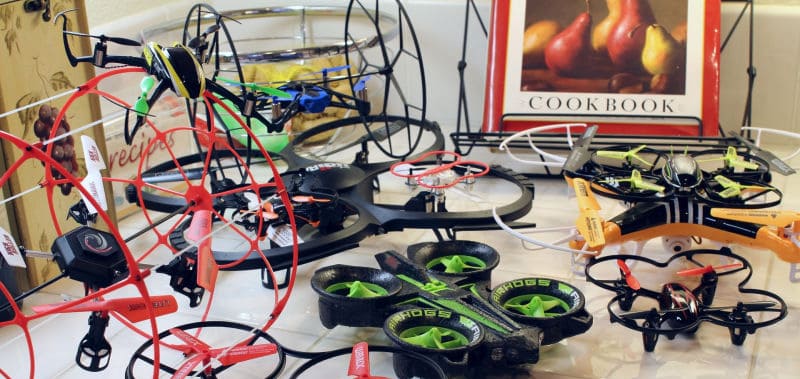


No comments:
Post a Comment